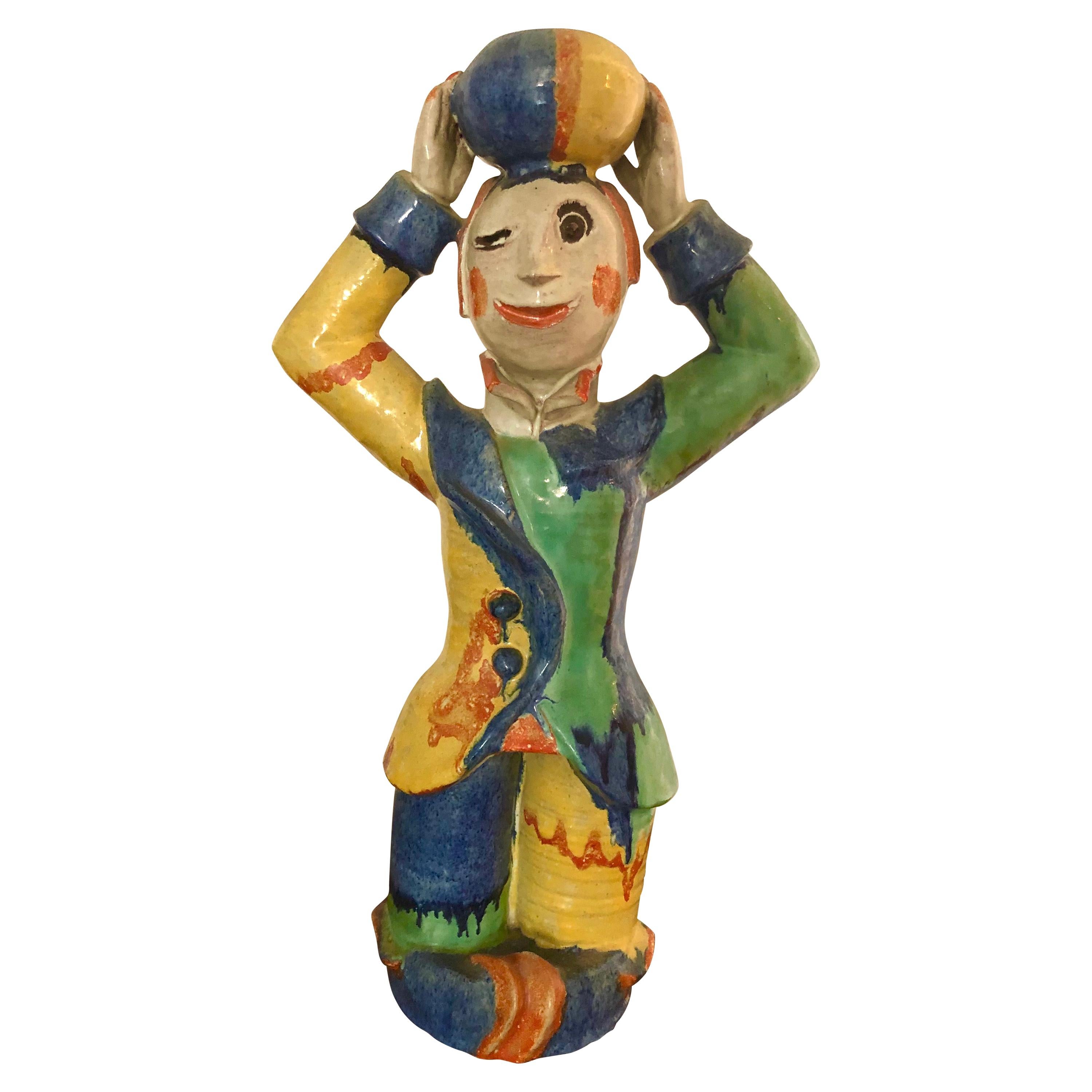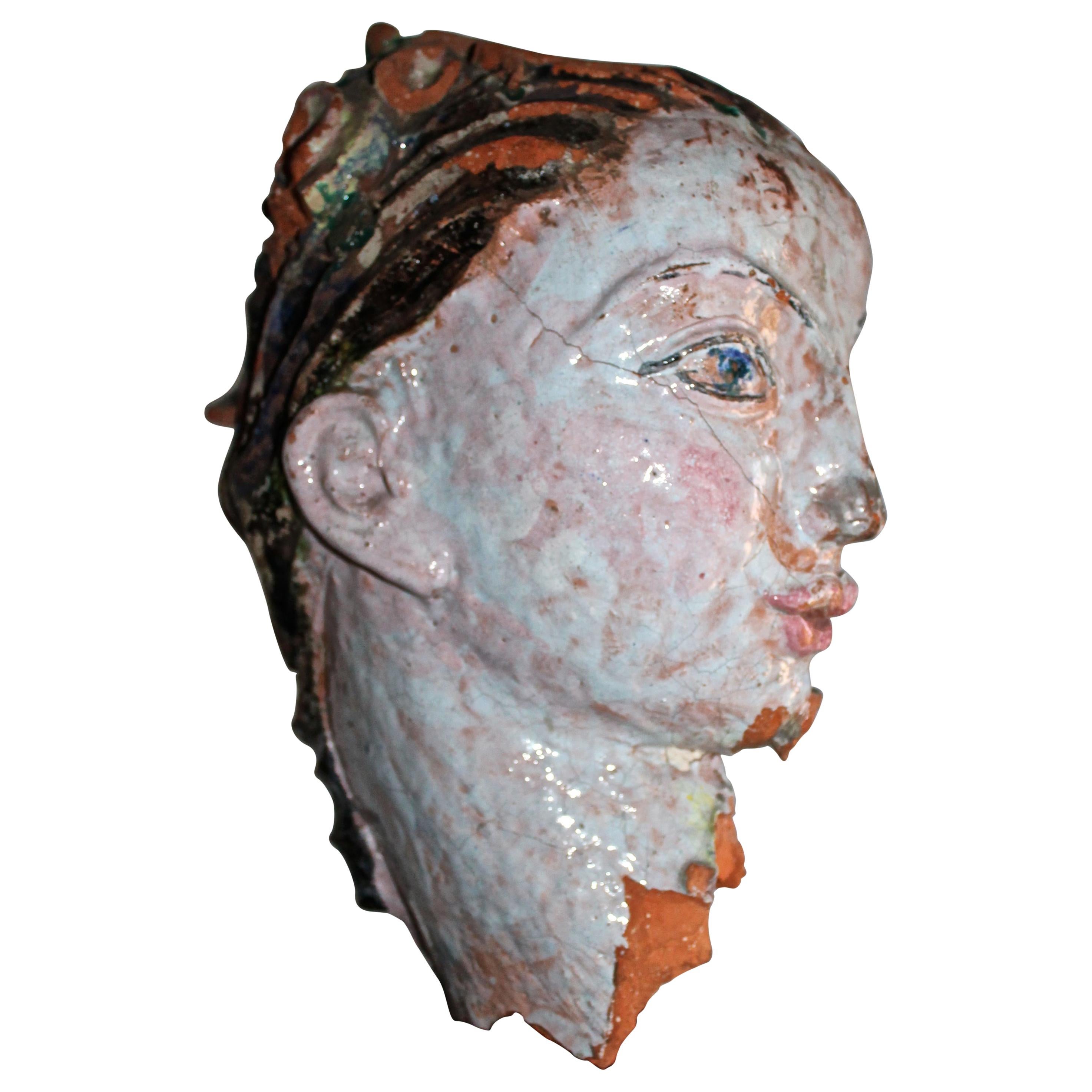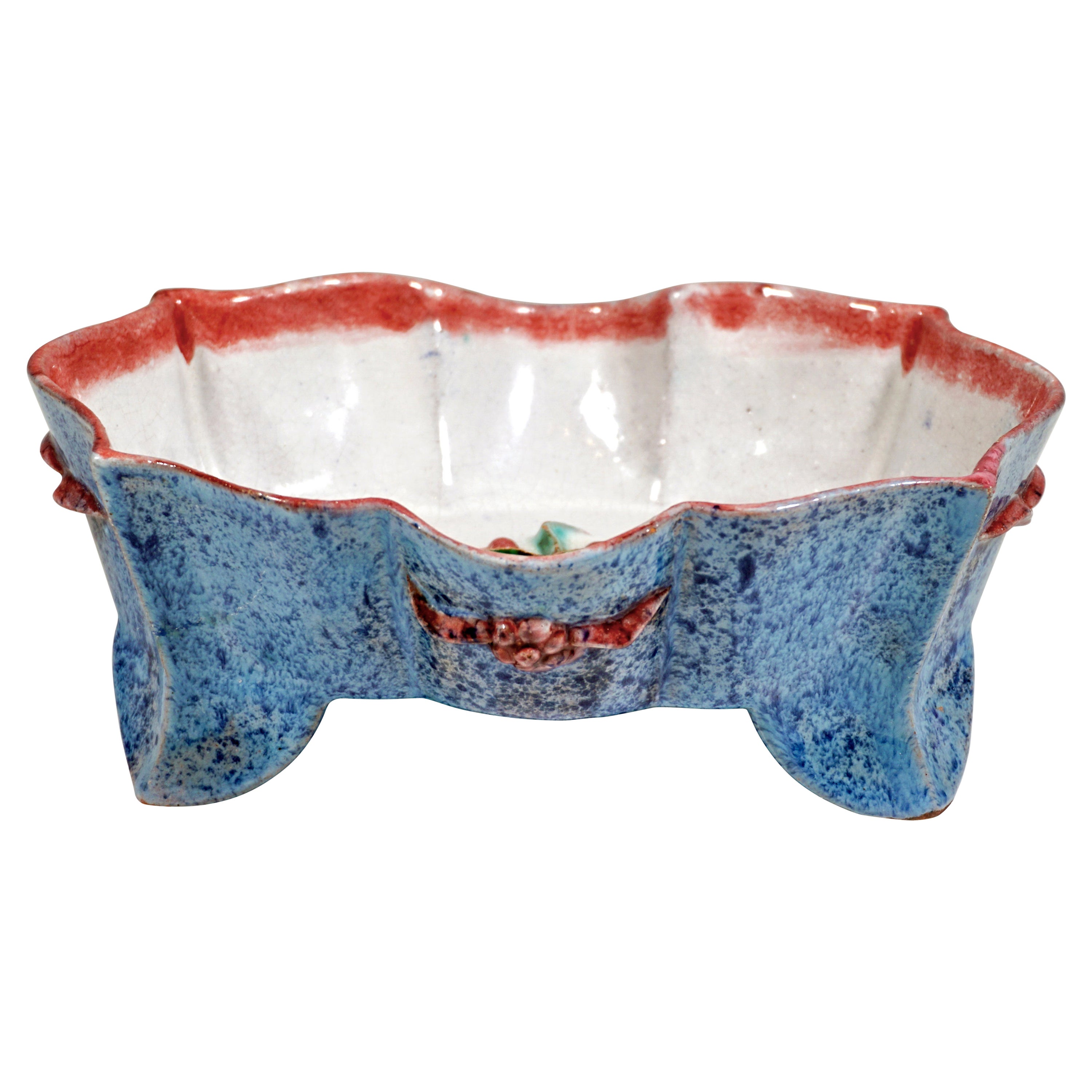Items Similar to Expressionist Ceramic Sculptural Vase Attributed to Vally Wieselthier, c. 1920
Want more images or videos?
Request additional images or videos from the seller
1 of 10
Expressionist Ceramic Sculptural Vase Attributed to Vally Wieselthier, c. 1920
About the Item
Although unsigned, this magnificent Austrian expressionist art ceramic sculptural vase with three receptacles is attributed to Vally Wieselthier for Wiener Werkstatte, ca. 1920.
Valerie "Vally" Wieselthier (Austrian-American, 1895 – 1945) was an outstanding ceramic artist. She was born to a Jewish family in Vienna, Austria. Her father, Wilhelm Wieselthier was a lawyer. Valluy attended theWiener Frauenacademie in Vienna from 1912 to 1914 and studied at the Vienna School of Applied Arts with Rosalinda Rothhansl, Kolo Moser, Jodef Hoffmann and Michael Powolny from 1914 to 1920. In addition, she worked as an auxiliary nurse during the First World War.
From 1917 to 1922, she worked for the Wiener Werkstatte. From 1922 to 1927, she ran her own ceramic workshop in cooperation with the Augarten porcelain factory, which was newly founded in 1923, but also with other companies such as Friedrich Goldschider, Gmundner Keramik and Lobmeyr.
Her expressive and humorous porcelain figures attracted attention at the Exposition Internationale des Arts Décoratifs et industriels modern in Paris in 1925 and are considered typical examples of the Art Deco style style. From 1928, the artist increasingly moved her center of life to the United States. She went to the International Exhibition of Ceramic Art in New York City in October 1928. In 1933, she moved to Chicago with Paul Lester Wiener and worked as a designer for the Contempora Group and the Sebring Pottery Company. Her extensive use of lead glazes and the potential effect of lead poisoning on her mental and physical health have not been evaluated, nonetheless. She died on September 1, 1945 of stomach cancer in a New York hospital.
Vally Wieselthier’s work is held by many museums, including the Metropolitan Museum of Arts in New York City of Arts and the Museum of Applied Arts in Vienna, Austria.
- Attributed to:Vally Wieselthier (Sculptor)
- Dimensions:Height: 13.25 in (33.66 cm)Width: 10.5 in (26.67 cm)Depth: 8.75 in (22.23 cm)
- Style:Expressionist (Of the Period)
- Materials and Techniques:
- Place of Origin:
- Period:
- Date of Manufacture:ca. 1920
- Condition:Wear consistent with age and use. We make our best effort to provide a fair and descriptive condition report. Please examine photos attentively, as they are an integral part of the description. Send us a message to request more details or discuss price.
- Seller Location:New York, NY
- Reference Number:1stDibs: LU2819331886082
About the Seller
5.0
Vetted Seller
These experienced sellers undergo a comprehensive evaluation by our team of in-house experts.
Established in 1993
1stDibs seller since 2017
68 sales on 1stDibs
Typical response time: 2 hours
- ShippingRetrieving quote...Ships From: New York, NY
- Return PolicyA return for this item may be initiated within 10 days of delivery.
More From This SellerView All
- Franz Xavier Bergmann, Sculptural Bud Vase, Vienna Bronze, circa 1900By Franz BergmannLocated in New York, NYDimensions Height: 7.25 inches Width: 5.25 inches Depth: 4.5 inches. Markings Fully marked on the bottom with a "B" in an urn-shaped cartouche (for “Bergmann”), and “GESHUTZED” (German: “PROTECTED). ABOUT What distinguishes this unique bud vase from others is a perfect synthesis of a utilitarian object and a Fine sculpture. It is not only the amazing subtlety and taste of the author’s artist skills, but an extraordinary design and an absolutely outstanding original plot. Designed for a single flower only, it is nonetheless a very complex and multifaceted composition filled with warm humor and fantasy. Sitting on a vessel shaped as a gourd, clasping its goat legs with hooves and holding on to the neck with one hand in order not to fall of it; a playful and mischievous faun holds by the tail a fleeing lizard with the other hand. FRANZ XAVIER BERGMANN (Austrian, 1861–1936) was the owner of a Viennese foundry who produced numerous patinated and cold-painted bronze oriental, erotic and animal figures, the latter often humanized or whimsical, humorous objects d'art. Cold painted bronze refers to pieces cast in Vienna and then decorated in several layers with so-called dust paint; the expertise for the mix of this kind of paint has been lost. The color was not fired hence "cold painted". Mainly women working...Category
Antique Early 1900s Austrian Jugendstil Vases
MaterialsBronze
- French Art Nouveau Patinated Bronze Sculptural Iris Vase, ca. 1900Located in New York, NYABOUT IRIS The iris is a special and mysterious flower. Not only because of its striking appearance, but also from an artistic and historical point of view. It is also like a work of art, as though created by Mother Nature. The unique leaves of this plant not only create wonderful shadow casts, but also look as if they were painted by hand. It's no wonder that iris acts as the muse for countless artists, and can be seen in many famous works of art. The iris was first spotted in the time of Pharaoh Thutmose, in 1504 BC. He had the iris inscribed into the wall reliefs of a temple as a sign of his power, as well as decorating his sceptre with motifs of the flower. Since then, the iris has been a symbol of victory in Egypt. But the symbolism of the iris goes further than that. In Japan, the flower represents courage and is the symbol of the boys' festival. In Islamic cultures, the iris is a symbol of prosperity. In Europe, the flower was a popular weapon symbol in the Middle Ages and stood for chivalry. And in Christianity, the iris was seen as a symbol of the trinity because of its three-part flowers. With more than 300 varieties, the iris is now the most popular flower among growers and gardeners following the rose. Countless artists use the iris in their works and the flower is present in all eras. You can see the flower on furniture, vases, jewelry, fabrics, sculptures, coats of arms and much more. Did you know that the iris is also called the sword lily? It's not a coincidence that it used to symbolize physical and emotional pain and suffering caused by a weapon. We also see the flower in religious art, where it's often associated with Mary and Jesus. The iris is also associated with the Greek goddess Iris, where the flower symbolizes reconciliation and divine messages. This is also reflected in many paintings. Finally, the iris is also visible in Dutch and Flemish still-life paintings. This can be in a religious form, incorporated into an object or as a decorative flower. In the Art Nouveau art movement, the iris (along with other plants, such as the birch) was often used as an expression of feminine beauty. With its almost otherworldly appearance, the iris is perfectly suited to the Art Nouveau aesthetic and is featured in many well-known works of art. The poet of that era, Hermann Hesse...Category
Antique Early 1900s French Art Nouveau Planters, Cachepots and Jardinières
MaterialsBronze
- Charles Vital-Cornu, French Art Nouveau Bronze Sculptural Floral Vase, 1900sBy Charles Vital-CornuLocated in New York, NYCharles Vital-Cornu (French, 1851 - 1927), Jouffroy’s and Pils’ pupil, he acquired a skillfulness mastery in carving marbles and producing bronzes. He used several patinas in his production. Indeed, if his pieces' embodiments are often golden-brown colored, the hollow part are darker. His figures, hands, faces, and bodies are of a great quality. Charles Vital-Cornu had participated in numerous annual ‘‘Salons’’ organized in Paris by ‘‘la Société des Artistes Français’’ where he got several awards, such as a mention of Honor in 1880 and 1881, a third class medal in 1882, a travelling grant in 1883, a second class medal in 1886, a bronze medal at the 1889 World Fair and, finally, a silver medal at the 1900 World Fair at the Grand palace...Category
Antique Early 1900s French Art Nouveau Vases
MaterialsBronze
- French Art Deco Art Glass and Wrought Iron Flower Vase, circa 1920sBy Charles SchneiderLocated in New York, NYAlthough unsigned, this Art Deco masterpiece in red and white art glass and wrought iron most probably by Charles Schneider. Charles and Ernest Schneider were a generation younger...Category
Vintage 1920s French Art Deco Vases
MaterialsWrought Iron
- Paul Dachsel for Turn Teplitz, Austrian Jugenstil Ceramic ‘Fern’ Vase, ca. 1900By Paul DachselLocated in New York, NYDETAILS: Fully marked on bottom. DIMENSIONS: height: 6.75 inches, width: 4.5 inches, depth: 4.5 inches ABOUT THE ARTIST Paul Dachsel (Czech, born circa 1880) was the son-in-law of Alfred...Category
Antique Early 1900s Austrian Art Nouveau Vases
MaterialsCeramic
- American Art Deco Anodized & Painted Metal Planter, ca. 1920sLocated in New York, NYAmerican Art Deco Planter with Geometrical Design Anodized & Painted Metal ca. 1920s DIMENSIONS Height: 13.5 inches Width: 14.5 inches Depth: 8.25 inchesCategory
Vintage 1920s American Art Deco Planters, Cachepots and Jardinières
MaterialsMetal
You May Also Like
- Vally Wieselthier for Wiener Werkstatte, Expressionist Lamp BaseBy Wiener Werkstätte, Vally WieselthierLocated in Brooklyn, NYCirca 1928, Austria, a wonderful example of Secessionist pottery from one of the undisputed masters. Depicting a male harlequin figure. Wiener Wer...Category
Vintage 1920s Austrian Vienna Secession Table Lamps
MaterialsPottery
- Vally Wieselthier Ceramic Head, Hand from Manhattan Wiener Werkstätte ShowroomBy Vally WieselthierLocated in Sharon, CTThis head and hand are all that remain of Vally Wieselthier’s masterpiece installed at the Wiener Werkstätte America's Manhattan NYC showroom. For an en situ photo see: Ronald S. Lauder Neue Galerie...Category
Vintage 1910s Austrian Vienna Secession Figurative Sculptures
MaterialsCeramic
- Crystal Vase, 1930, Attributed to Val Saint LambertBy Val Saint LambertLocated in Ciudad Autónoma Buenos Aires, CVase of crystal We have specialized in the sale of Art Deco and Art Nouveau and Vintage styles since 1982. If you have any questions we are at your disposal. Pushing the button that ...Category
Vintage 1930s Belgian Art Deco Crystal Serveware
MaterialsCrystal
- Wiener Werkstaette Art Ceramics Expressive Style Beer Mug by V. Wieselthier 1919By Wiener Werkstätte, Vally WieselthierLocated in Vienna, ATSlender jug, which widens in the upper part and narrows at the top again, with spout and opposite handle, surface decorated in relief with three antique-style heads and stylized, sla...Category
Vintage 1910s Austrian Expressionist Ceramics
MaterialsCeramic
- Wiener Werkstaette Art Ceramics Expressive Style Bowl by Vally Wieselthier, 1921By Wiener Werkstätte, Vally WieselthierLocated in Vienna, ATBowl on an oval ground plan with flared, wavy and curved walls on four swept-out feet, fruit and leaf decoration in relief on the bowl base and on the outside, colored glazed in an e...Category
Vintage 1920s Austrian Expressionist Ceramics
MaterialsCeramic
- Wiener Werkstätte Art Ceramics, Expressive Style Bowl by Vally Wieselthier, 1921By Wiener Werkstätte, Vally WieselthierLocated in Vienna, ATLarge bowl on an oval ground plan with flared, wavy and curved walls on four swept-out feet in the shape of leaves, flower and leaf decoration in relief on the bowl base and on the o...Category
Vintage 1920s Austrian Expressionist Ceramics
MaterialsCeramic
Recently Viewed
View AllMore Ways To Browse
Unsigned Attributed
Austrian Vase Painted
Lawyer Style
Moser Vase
American Art Deco Vase
Group Pottery Vases
Ceramic Austrian Vase
Wiener Werkstatte Style
Art Deco Style Ceramic Vases
1895 Porcelain
Jewish Objects
Glazed Ceramic Vienna
Vienna Style Three
Lobmeyr Vienna
Vienna Style Vases
Moser Art Deco
Moser Wiener Werkstatte
Moser Applied





